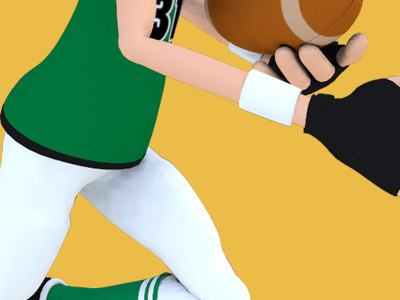American football

Football Single
In Canadian football, a single (single point, or rouge), scoring one point, is awarded when the ball is kicked into the end zone by any legal means, other than a successful field goal, and the receiving team does not return, or kick, the ball out of its end zone. It is also a single if the kick travels through the end zone or goes out of bounds in the end zone without being touched, except on a kickoff. After conceding a single, the receiving team is awarded possession of the ball at the 35-yard line of its own end of the field.
Singles are not awarded in the following situations:
- if a ball is downed in the end zone after being intercepted in the end zone
- if a ball is fumbled outside the end zone
- if the kicked ball hits the goalposts (since the 1970s; before then it was a live ball)
- when a kickoff goes into the end zone and then out of bounds without being touched
In all these cases the defending team is awarded possession of the ball at the 25-yard line.
In the United States, singles are not usually recognized in most leagues and are awarded only in matches played under the auspices of the National Indoor Football League and the now-defunct American Indoor Football Association. It is applied only on kickoffs in both leagues, and is scored if the receiving team fails to advance the ball out of the end zone when kicked. The NIFL and AIFA also allowed a single to be scored by kicking a kickoff through the uprights (as in a field goal); this type of single is nicknamed (and has since been codified in the AIFA rules as) an uno, from the Spanish word for the number one.
There is one other way to score a single point on a gridiron football play, outside of the routine extra point: if either team scores a safety on a conversion attempt after a touchdown, one point is awarded.
The Canadian Football League has discussed abolishing the single but proposals to do so as recently as 2005 have been rejected. A less sweeping proposal would see the single eliminated on punts and field goal attempts that pass out the sidelines of the end zone – such a change would eliminate the "consolation" point for a failed coffin corner attempt. Another proposal would have the rouge scored only when kicks from scrimmage are deemed 'returnable' having touched the end zone or a return team player without being advanced back into the field of play.
In the official rules, the single point is also called a rouge, French for "red", and the origin is unclear. One theory is that a red flag was used to signal the score in the game's early days. Another is that, because the conceding team had a point deducted from its score on the play in earlier days, the tally was called a "red point".
However, the concept of the rouge dates back to several public school sports played in England from the early 19th century. In rossall hockey played at Rossall School, and the Eton Field Game, both of which are still played today, a rouge can be scored after the ball has gone into the local equivalent of the 'end zone' after striking another player. The Sheffield Rules, a 19th-century code of football, also utilized the rouge as a secondary scoring method. The behind used in Australian rules football is similar in concept to the Canadian single (a goal in that code is six points, but narrowly missing either side of the goal scores one point), as is the point in Gaelic football (where goals that go into the net score three points but balls that go over the crossbar score just one).
SPORTS



American Football
Game play in American football consists of a series of downs, individual plays of short duration, outside of which the ball is dead or not in play. These can be plays from scrimmage – passes, runs, punts, or field goal attempts (from either a place kick or a drop kick) – or free kicks such as kickoffs and fair catch kicks. Substitutions can be made between downs, which allows for a great deal of specialization as coaches choose the players best suited for each particular situation. During a play, each team should have no more than 11 players on the field, and each of them has specific tasks assigned for that specific play.
Rules and gameplay
- Scoring
- Maneuvers
- Strategy
- Play types
- Penalties
- Turnovers
- Downs
- Teams and positions
- Field
- Equipment
- Duration and time stoppages
- Advancing the ball and downs
- Kicking
- Officials and fouls
Positions
Offensive (Interior) line
Backs and receivers
Defensive line
Linebackers
Defensive backs
Special teams
- Kicker (K)
- Holder (H)
- Long snapper (LS)
- Punter (P)
- Kickoff specialist (KOS)
- Kick returner (KR) and Punt returner (PR)
- Upback
- Gunner
- Jammer


RESOURCES
This article uses material from the Wikipedia articles "American football", "American football rules", "Single", which is released under the Creative Commons Attribution-Share-Alike License 3.0.
© Stories Preschool. All Rights Reserved.





